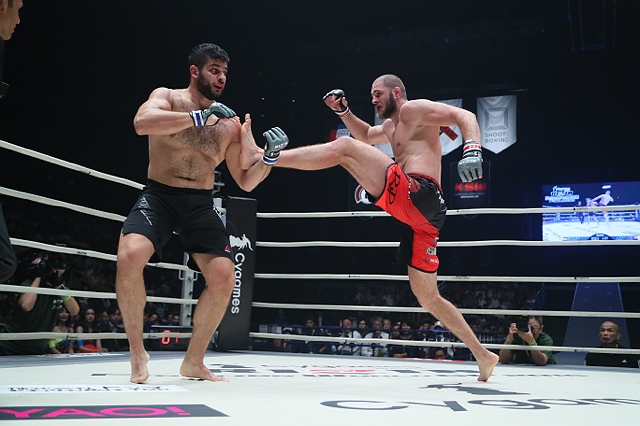Jiří Procházka faces Glover Teixeira for the UFC light heavyweight title in the main event of UFC 275 this Saturday, Jun. 11, at the Singapore Indoor Stadium. While Procházka has been impressive thus far in his UFC tenure, he has displayed some vulnerabilities that could be exploited by Teixeira. Will he be able to adapt his game this weekend?
Procházka is an unorthodox, powerful individual, but he also appears to have some glaring weaknesses. One of these seems to be his ground game. With Teixeira being an excellent Jiu-Jitsu player – with 10 career submission victories – Procházka must demonstrate vast improvements on the ground from his last fight. His tendency to keep his hands low does help him anticipate and defend takedowns. However, the Czech fighter likes to throw big, lunging punches, which expose his hips and give his opponents an easier path to secure a takedown. Procházka was taken down fairly easily by Dominick Reyes, who is not renowned for his wrestling ability. The 29-year-old showcased his immense athleticism by exploding to get up, but he did give up his back in the process. Reyes was unable to capitalize on this mistake, but Teixeira will almost certainly make Procházka pay in this scenario.
It is unlikely that Procházka will alter his striking style, considering it has made him so successful but he may adjust his mentality in the cage. Against Volkan Oezdemir and Reyes, Procházka marched forward with reckless abandon. This game plan paid off on both occasions, despite the Czech native having to deal with adversity against Reyes. However, neither of those two men presented the level of danger on the ground that Teixeira will this Saturday. With this in mind, Procházka may need to exercise more caution and look to pick his moments to attack in the stand up. Teixeira’s primary game plan will almost certainly be to take Procházka down. The challenger must ensure that he is not overzealous on the feet and prevents Teixeira from securing comfortable takedowns.
Procházka must also avoid getting preoccupied with Teixeira’s ground game and forgetting about his striking. The Brazilian has knockout power, and he channels this through his solid boxing fundamentals. Teixeira’s right-hand-left-hook combination has brought him tremendous success throughout his career and it played a major part in his title-winning effort against Jan Blachowicz. In the second round of that contest, Teixeira backed Blachowicz up and landed the aforementioned combination. Blachowicz never fully recovered from this and got submitted less than a minute later. Procházka likes to keep his hands low and relies on his footwork to evade punches. This is a risky strategy against Teixeira, and it will be particularly exposed if the 29-year-old gets pushed up against the cage.
Procházka won’t change his approach of keeping his hands low, but he could keep himself safe against Teixeira by fighting the champion at range. Procházka utilizes front kicks and teeps to back up his opponents. Using these types of weapons will enable him to sustain offence without putting himself at risk of getting caught with big punches.
The aforementioned Reyes was repeatedly able to connect with counter-lefts against Procházka. Teixeira’s forward pressure is one of his strengths, but he has also proven that he is adept at hurting opponents off the back foot. Against Ryan Bader, the Brazilian got hurt and retreated to the fence. Bader threw a couple of big punches, which Teixeira blocked before he executed his trademark combination, which dropped the American, and Teixeira secured the finish with ground-and-pound strikes.
Procházka can avoid getting caught by counters by not planting his feet after he lands strikes. Against Reyes, Procházka was flat-footed and was over extending himself after he connected and hurt the California native. He will need to be more agile against the champion, who is very comfortable brawling at close quarters.
Another adaptation that Procházka may have to do could be his reaction to hurting an opponent. Throughout his career, the 29-year-old has often quickly followed hurt opponents to the ground and has aggressively thrown ground-and-pound strikes in order to finish them. Teixeira has an uncanny ability to recover and finish opponents after seemingly being badly compromised. He displayed this quality against both Thiago Santos and Ion Cutelaba. His recovery against Santos in particular, showed how resilient the 42-year-old is. Santos is widely regarded as the biggest puncher in the division and, despite dropping Teixeira, he was unable to finish him. After Teixeira got hurt, he scrambled and initiated a takedown before landing a barrage of punches. Teixeira then cinched in a rear-naked choke and Santos tapped almost immediately.
This shows that no matter how confident Procházka is in his capability to knock Teixeira out, he must be wary of the Brazilian’s durability. Teixeira’s jiu-jitsu skills have helped him when he has been dropped in the past, as he can find a way to minimize the damage and recover before he delivers his own offense. Santos fatigued when he tried to finish Teixeira, and Procházka must ensure he avoids making the same mistake.
If he does hurt Teixeira, he may be better off waiting and letting him get back up, rather than following him down. Teixeira is in his comfort zone on the ground, and his grappling expertise helps him navigate his way through difficult predicaments.
This Saturday, Procházka will be competing for a UFC world championship in just his third bout inside the Octagon. He has established himself as a force of nature and, at just 29 years old, he seems to have his best years ahead of him. It will be intriguing to see if a man as principled and assured as Procházka will be able to adjust if things do not play out exactly how he expects. This factor may prove to be the difference between winning and losing.

